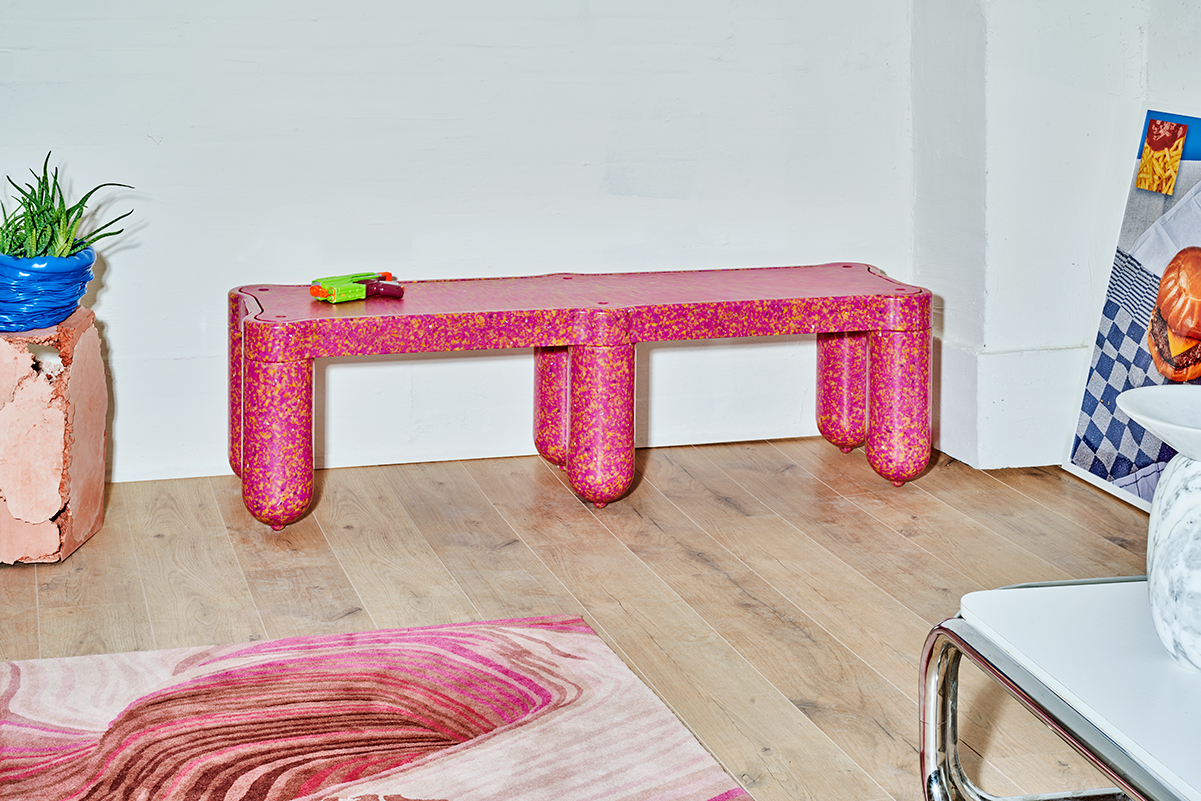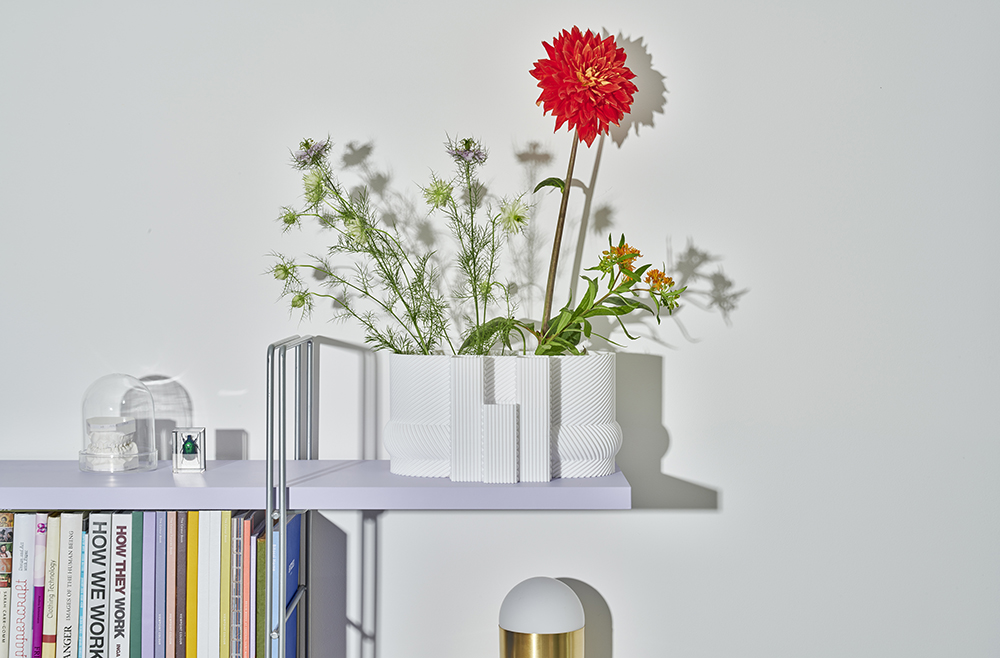Plastic waste is being converted into filaments used to 3D print unique furniture and objects. Supernovas, a recently launched London and Milan-based circular design and lifestyle company, has shown that PET plastic waste from recycled bottles and product packaging can be transformed into recycled and recyclable products that are not only sustainable but also beautiful. This revolutionary way to re-use waste drives attention toward circular economy models proven to work by changing the production methods of consuming goods and services, significantly reducing the environmental pressure from increasingly demanding consumers.
Since its launch in the Summer of 2020, Supernovas has launched its first two collections: Volta and Afterlife. Created in collaboration with Italian-Brazilian industrial designer Paula Cademartori, Volta brings various tableware and stationery pieces with architectural shapes. Using recycled filaments made from thermoplastic polyester PETG, commonly used to manufacture water bottles, Cademartori 3D prints colorful stylistic elements, including vases, jewelry trays, and desk organizers.
One of the popular items of the line is a Valentine’s Day-inspired smartphone stand. The special edition of Volta’s Pega stand called “Love The Planet” is made from recycled polyethylene terephthalate glycol (RPETG), which comes from post-manufacturing PETG scrap. At €37 ($45), the product’s eye-catching multi-color design introduces Supernovas’ new “planet flag,” a combination of shades directly inspired from the earth elements: blue for the oceans, brown for the soil, coral for fire, green for the forests and yellow for the sun. Super-strong and resistant, Pega “Love the Planet” is made from the equivalent of nine discarded plastic bottles and is fully recycled and recyclable.

Pega “Love the Planet” is a Valentine’s Day-inspired smartphone stand 3D printed from recycled bottles. Image courtesy of Supernovas.
With the Afterlife collection, Supernovas has pioneered the combination of three cutting-edge manufacturing techniques to produce recycled, buildable objects. They use rotomoulding, pressing, and 3D printing to create the products. For this project, the startup challenged Dutch design studio Odd Matter to develop an easy-to-assemble furniture collection that empowers dynamic living, with designs that “give waste an afterlife” and ensure the products’ recyclability at the end of their life cycle. Afterlife is made from post-consumer and post-industrial plastic waste streams. Namely, those found in bottles, packaging, squeeze bottles, toys, and gas and water pipes. In just a few months, the Afterlife collection has already won the 2021 Wallpaper* Design Award for “Best Use of Material.”
Afterlife’s core creation is Bench, an easy to assemble product with multiple uses. Suitable for indoors or outdoors, Benches can be stacked one on top of the other thanks to a unique stacking system, capable of going from comfortable sitting furniture to shelves. Afterlife’s Bench weighs 22 kilos (48 pounds) and comes with a bespoke 3D printed bolt made from 100% recycled PETG, making it super easy to assemble without any external tools. One of Supernovas’ most expensive products, the Bench, goes for €1,674 ($2029).

Supernovas’ Afterlife Bench, a stackable bench made from recycled waste and using 3D printing technology. Image courtesy of Supernovas.
Concerned about the unyielding environmental impact of plastic consumption, Supernovas’ Founder and CEO Massimiliano Rossi has also implemented the circular economy model in terms of service design by launching a one-of-a-kind member program that allows customers to return their products or swap them for alternatives as they adapt to lifestyle and taste changes. Called Streaming, the environmentally friendly model sees that the materials will never become waste again. Even more so, to ensure their full recyclability, Supernovas products are mono-material, made from 100% recycled sourced and without glues, which can’t always be removed during the recycling process.
In addition to creating unique products gaining significant traction in the design world, Supernovas collaborates with corporations and municipalities to transform their waste streams into circular products and projects and bring sustainability and innovation within their organizations. It is a one-stop-shop for circular design, consulting both from a strategy and implementation perspective, including material collection, product design, engineering, prototyping, manufacturing, branding, and packaging. The recycled-designs company offers solutions tailored to their partners. Amongst its collaborations, Supernovas Studio has worked on Good Blue, the first sustainable fast-food store made entirely with recycled materials, and is currently on track with WOW, a project transforming waste from concerts into designs for fans.

Super-strong and resistant, the Muito Grande vase is made from the equivalent of 75 discarded plastic bottles. Image courtesy of Supernovas.
Worried about the 25 million tons of home and office furniture disposed of by the U.S. and Europe every year – and less than 1% recycled – Supernovas set out to change the paradigm. In the U.S. alone, the amount of furniture and furnishings taken to a landfill rose from 2.1 million tons in 1960 to 9.7 million tons in 2018. Moreover, the rate of increase is accelerating, stated the Environmental Protection Agency (EPA).
Similarly, furniture waste in the European Union (EU) accounts for more than 4% of the total municipal solid waste (MSW) stream. According to the European Federation of Furniture Manufacturers (UEA) statistics, the total annual furniture waste equates to 10.78 million tonnes, with between 80% to 90% of the waste ending up incinerated or sent to landfills. Even more worrisome, reuse activity in the sector is considered low and mostly done through commercial second-hand shops, social enterprise companies, or charities.
By transforming waste and unwanted material into meticulously designed and crafted products that can also be recycled, Supernovas molds its products to the customers’ lifelong journey, wherever it may take them. The brand’s designs are not the only products using recycled filaments and 3D printing technology to diversify the furniture market. For example, Netherlands-based design studio The New Raw created the Zero Waste Lab to design street furniture 3D printed from local plastic trash. Simultaneously, adventurer and biologist Glenn Mattsing founded Sculptur, a company that fishes plastic waste out of the oceans to 3D print designer furniture. Every year we encounter more companies turning to 3D printing for innovative ways to develop unique pieces of furnishings.
For Supernovas, their designs combining cutting-edge technology and collaborations with top-class global creatives, which could quickly go from 15 products to dozens of sustainable lifestyle items. The demand for eco-friendly furniture is growing and expected to reach $59.8 billion by 2027. Moreover, additive technologies can contribute to the sustainable development of furniture, objects, and other design products, helping innovative creators rethink how to produce original pieces without harming the environment.
Subscribe to Our Email Newsletter
Stay up-to-date on all the latest news from the 3D printing industry and receive information and offers from third party vendors.
You May Also Like
Profiling a Construction 3D Printing Pioneer: US Army Corps of Engineers’ Megan Kreiger
The world of construction 3D printing is still so new that the true experts can probably be counted on two hands. Among them is Megan Kreiger, Portfolio Manager of Additive...
US Army Corps of Engineers Taps Lincoln Electric & Eaton for Largest 3D Printed US Civil Works Part
The Soo Locks sit on the US-Canadian border, enabling maritime travel between Lake Superior and Lake Huron, from which ships can reach the rest of the Great Lakes. Crafts carrying...
Construction 3D Printing CEO Reflects on Being Female in Construction
Natalie Wadley, CEO of ChangeMaker3D, could hear the words of her daughter sitting next to her resounding in her head. “Mum, MUM, you’ve won!” Wadley had just won the prestigious...
1Print to Commercialize 3D Printed Coastal Resilience Solutions
1Print, a company that specializes in deploying additive construction (AC) for infrastructure projects, has entered an agreement with the University of Miami (UM) to accelerate commercialization of the SEAHIVE shoreline...





























